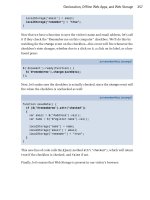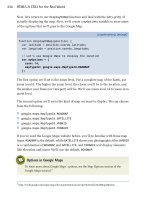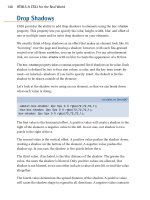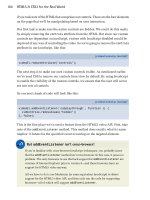Ebook Information systems today Managing in the digital world Part 1
Bạn đang xem bản rút gọn của tài liệu. Xem và tải ngay bản đầy đủ của tài liệu tại đây (27.46 MB, 265 trang )
Could you increase your knowledge—
and raise your grade—if you…
…used an online tutorial that assisted you with Access
and Excel skills mapped to this book?
…learned to use Microsoft’s SharePoint, the number 1
organizational tool for file sharing and collaboration?
…had flash cards and student PowerPoints to prepare
for lectures?
Visit
, a valuable tool
for your student success and your
business career.
www.myMISlab.com
Information
Systems Today
Managing in the Digital World
This page intentionally left blank
Information
Systems Today
FIFTH
EDITION
Managing in the Digital World
Joe Valacich
Washington State University
Christoph Schneider
City University of Hong Kong
Prentice Hall
Boston Columbus Indianapolis New York San Francisco Upper Saddle River
Amsterdam Cape Town Dubai London Madrid Milan Munich Paris Montreal Toronto
Delhi Mexico City Sa˜o Paulo Sydney Hong Kong Seoul Singapore Taipei Tokyo
Editorial Director: Sally Yagan
Editor in Chief: Eric Svendsen
Executive Editor: Bob Horan
Editorial Project Manager: Kelly Loftus
Director of Marketing: Patrice Lumumba Jones
Senior Marketing Manager: Anne Fahlgren
Marketing Assistant: Melinda Jensen
Senior Managing Editor: Judy Leale
Production Project Manager: Kelly Warsak
Senior Operations Supervisor: Arnold Vila
Operations Specialist: Cathleen Petersen
Creative Director: Christy Mahon
Senior Art Director/Design Supervisor: Janet Slowik
Interior and Cover Designer: Michael Fruhbeis
Cover Art: Michael Fruhbeis
Manager, Rights and Permissions: Hessa Albader
Media Project Manager: Lisa Rinaldi
Media Editor: Denise Vaughn
Full-Service Project Management: Tiffany Timmerman/S4Carlisle
Publishing Services
Composition: S4Carlisle Publishing Services
Printer/Binder: R.R. Donnelley/Roanoke
Cover Printer: Lehigh-Phoenix Color/Hagerstown
Text Font: 9/11 Times
Credits and acknowledgments borrowed from other sources and reproduced, with permission, in this textbook appear on appropriate page
within text.
Microsoft® and Windows® are registered trademarks of the Microsoft Corporation in the U.S.A. and other countries. Screen shots and icons
reprinted with permission from the Microsoft Corporation. This book is not sponsored or endorsed by or affiliated with the Microsoft Corporation.
Copyright © 2012, 2010, 2008, 2006, 2003 Pearson Education, Inc., publishing as Prentice Hall, One Lake Street, Upper Saddle River,
New Jersey 07458. All rights reserved. Manufactured in the United States of America. This publication is protected by Copyright, and
permission should be obtained from the publisher prior to any prohibited reproduction, storage in a retrieval system, or transmission in any form
or by any means, electronic, mechanical, photocopying, recording, or likewise. To obtain permission(s) to use material from this work, please
submit a written request to Pearson Education, Inc., Permissions Department, One Lake Street, Upper Saddle River, New Jersey 07458.
Many of the designations by manufacturers and seller to distinguish their products are claimed as trademarks. Where those designations appear
in this book, and the publisher was aware of a trademark claim, the designations have been printed in initial caps or all caps.
Library of Congress Cataloging-in-Publication Data
Valacich, Joseph S.
Information systems today: managing in the digital world/Joe Valacich,
Christoph Schneider.—5th ed.
p. cm.
Includes bibliographical references and indexes.
ISBN-13: 978-0-13-706699-5
ISBN-10: 0-13-706699-6
1. Information technology. 2. Information storage and retrieval systems—Business.
I. Schneider, Christoph II. Title.
T58.5.J47 2012
658.4’038011—dc22
2010043082
10 9 8 7 6 5 4 3 2 1
ISBN 10:
0-13-706699-6
ISBN 13: 978-0-13-706699-5
Dedication
To Jackie, Jordan, and James for your sacrifices, love, and support.
—Joe
To Birgit for your love and support.
—Christoph
This page intentionally left blank
About the Authors
Joe Valacich is the George and Carolyn Hubman Distinguished Professor of MIS and was the
inaugural Marian E. Smith Presidential Endowed Chair at Washington State University. He has
had visiting faculty appointments at the University of Arizona, City University of Hong Kong,
Buskerud College (Norway), and the Helsinki School of Economics and Business. He currently
teaches in summer programs for the Norwegian University of Life Sciences and Riga Technical University (Latvia). He received the PhD degree from the University of Arizona (MIS) and
the MBA and BS (computer science) degrees from the University of Montana. Prior to his
academic career, Dr. Valacich worked in the software industry in Seattle in both large and startup organizations.
Dr. Valacich has served on various national task forces designing model curricula for the information systems discipline, including IS ’97, IS 2002, and IS 2010: The Model Curriculum and
Guidelines for Undergraduate Degree Programs in Information Systems, where he was cochairperson. He also served on task force that designed MSIS 2000 and 2006: The Master of Science
in Information Systems Model Curriculum. He served on the executive committee, funded by the
National Science Foundation, to define the IS Program Accreditation Standards and served on the
board of directors for CSAB (formally, the Computing Sciences Accreditation Board) representing
the Association for Information Systems (AIS). He was the general conference cochair for the
2003 International Conference on Information Systems (ICIS) in Seattle, and was the vice chair
of ICIS 1999 in Charlotte, North Carolina. He is the general conference cochair for the 2012
Americas Conference on Information Systems (AMCIS) in Seattle.
Dr. Valacich has conducted numerous corporate training and executive development programs for organizations, including AT&T, Boeing, Dow Chemical, EDS, Exxon, FedEx, General
Motors, Microsoft, and Xerox. He is currently a senior editor at MIS Quarterly and is on the
editorial boards at Decision Sciences and Small Group Research. He was previously an associate
editor (two terms) at Information Systems Research. His primary research interests include
human–computer interaction, technology-mediated collaboration, mobile and emerging technologies, e-business, and distance education. He has published more than 80 scholarly articles in
numerous prestigious journals, including MIS Quarterly, Information Systems Research,
Management Science, Academy of Management Journal, Journal of MIS, Decision Sciences,
Journal of the AIS, Communications of the ACM, Organizational Behavior and Human Decision
Processes, and Journal of Applied Psychology. He is a coauthor of the best-selling textbooks
Modern Systems Analysis and Design (6th ed.), Essentials of Systems Analysis and Design (4th
ed.), Object-Oriented Systems Analysis and Design (2nd ed.), and Information Systems Project
Management (1st ed.); all are published by Prentice Hall.
Dr. Valacich was awarded the 2009 Outstanding Alumnus Award by the School of Business
Administration, University of Montana. Also, in 2009, MIS Quarterly selected his 2008 paper
“Media, Tasks, and Communication Processes: A Theory of Media Synchronicity” as its Paper of
the Year, and he was ranked as one of 25 most prolific scholars in the history of MIS Quarterly
over the 32-year life of the journal (1977–2008). Also in 2009, he was named a Fellow of the
Association for Information Systems. He has won the Outstanding Researcher Award in 2006 and
again in 2008 by the College of Business, Washington State University.
Christoph Schneider is an assistant professor in the Department of Information Systems at City
University of Hong Kong and previously held a visiting faculty appointment at Boise State
University. He earned a Swiss Higher Diploma in hotel management at the University Centre
César Ritz in Brig, Switzerland, and a BA in hotel and restaurant administration at Washington
State University. Following extensive experience in the international hospitality industry, he studied information systems at the Martin Luther University in Halle, Germany, before joining the
vii
viii
ABOUT THE AUTHORS
information systems department at Washington State University to earn his PhD degree. His
teaching interests include the management of information systems, business intelligence, and
enterprise-wide information systems.
Dr. Schneider is an active researcher. His primary research interests include human–computer
interaction, electronic commerce, and computer-mediated collaboration. His research has appeared in peer-reviewed journals, such as Information Systems Research, Management Information Systems Quarterly, Management Science, and IEEE Transactions on Professional
Communication; further, he has presented his research at various national and international conferences, such as the International Conference on Information Systems, the European Conference
on Information Systems, and the Hawaii International Conference on System Sciences. He is a
member of the International Advisory Committee of the International Conference on Information
Systems Development.
Brief Contents
Preface xxi
Chapter 1
Managing in the Digital World 2
Chapter 2
Gaining Competitive Advantage Through Information Systems
52
Chapter 3
Managing the Information Systems Infrastructure and Services
96
Chapter 4
Enabling Commerce Using the Internet
Chapter 5
Enhancing Collaboration Using Web 2.0
Chapter 6
Enhancing Business Intelligence Using Information Systems
Chapter 7
Enhancing Business Processes Using Enterprise Information
Systems 278
Chapter 8
Improving Supply Chains and Strengthening Customer Relationships
Using Enterprise Information Systems 316
Chapter 9
Developing and Acquiring Information Systems
Chapter 10 Securing Information Systems
142
192
234
352
398
Technology Briefing Foundations of Information Systems Infrastructure 448
Acronyms 501
Glossary
503
References 523
Name Index 531
Organization Index 535
Subject Index 537
ix
This page intentionally left blank
Contents
Preface xxi
Chapter 1
Managing in the Digital World
2
MANAGING IN THE DIGITAL WORLD: Apple Computer
3
Information Systems Today 5
Characteristics of the Digital World 6
The Information Age Arrives 7
■ WHEN THINGS GO WRONG: Failure: The Path to Success? 8
Evolution of Globalization 10
Globalization 1.0 10
Globalization 2.0 11
■ NET STATS: Worldwide Internet Usage 12
Globalization 3.0 12
The Rise of Outsourcing 15
■ COMING ATTRACTIONS: Real-Time Language Translation 16
Opportunities of Operating in the Digital World 18
Challenges of Operating in the Digital World 19
■ ETHICAL DILEMMA: Online Rights Not Always Universal 20
Information Systems Defined 21
Data: The Root and Purpose of Information Systems 22
Hardware, Software, and Telecommunications Networks: The Components
of Information Systems 23
People: The Builders and Managers of Information Systems 23
■ POWERFUL PARTNERSHIPS: The Two Steves—
Jobs and Wozniak 24
Organizations: The Context of Information Systems 29
The Dual Nature of Information Systems 33
Case in Point: An Information System Gone Awry: Software Glitch Stops Hybrid
Vehicle (or Doesn’t?) 33
Case in Point: An Information System That Works: FedEx 34
Information Systems for Competitive Advantage 35
Why Information Systems Matter 35
IS Ethics 36
Information Privacy 36
Information Accuracy 38
Information Property 38
Information Accessibility 40
The Need for a Code of Ethical Conduct 40
The Digital Divide 41
■ BRIEF CASE: Guerilla Wi-Fi Helps to Bridge the Divide 42
■ INDUSTRY ANALYSIS: Business Career Outlook 43
xi
xii
CONTENTS
Key Points Review 45 • Key Terms 46 • Review Questions 46
• Self-Study Questions 46 • Problems and Exercises 47 • Application
Exercises 48 • Answers to the Self-Study Questions 49
■ BRIDGING THE DIGITAL DIVIDE 49
■ ENABLING GLOBAL PAYMENTS AT PAYPAL 50
Chapter 2
Gaining Competitive Advantage Through
Information Systems 52
MANAGING IN THE DIGITAL WORLD: Home Media—You’re in Control
53
Enabling Organizational Strategy Through Information Systems 54
Organizational Decision-Making Levels 54
Organizational Functional Areas 57
Information Systems for Automating: Doing Things Faster 58
Information Systems for Organizational Learning: Doing Things Better 58
Information Systems for Supporting Strategy: Doing Things Smarter 60
■ BRIEF CASE: For Sale by Owner: Your Company’s Name.com 61
■ NET STATS: Online Searching 62
Sources of Competitive Advantage 63
Identifying Where to Compete: Analyzing Competitive Forces 63
Identifying How to Compete: Analyzing the Value Chain 64
The Role of Information Systems in Value Chain Analysis 65
The Technology/Strategy Fit 65
Assessing Value for the IS Infrastructure 66
Changing Mind-Sets About Information Systems 67
International Business Strategies in the Digital World 67
■ WHEN THINGS GO WRONG: e-Waste Is a Global Problem 68
Home-Replication Strategy 69
Global Business Strategy 70
Multidomestic Business Strategy 70
Transnational Business Strategy 72
Valuing Innovations 72
The Need for Constant IS Innovation 73
Successful Innovation Is Difficult 73
Organizational Requirements for Innovation 75
Predicting the Next New Thing 75
■ COMING ATTRACTIONS: TV and Mobile Content for the Visually
Impaired 76
The Innovator’s Dilemma 77
■ POWERFUL PARTNERSHIPS: The Disruptive Duo: Niklas Zennström
and Janus Friis 80
Freeconomics: Why Free Products Are the Future of the Digital World 83
How Freeconomics Works 83
■ ETHICAL DILEMMA: Underground Gaming Economy 84
The Freeconomics Value Proposition 85
Applying Freeconomics in the Digital World 86
■ INDUSTRY ANALYSIS: Banking Industry 87
Key Points Review 88 • Key Terms 89 • Review Questions 89
• Self-Study Questions 89 • Problems and Exercises 90 • Application
Exercises 91 • Team Work Exercise: Pizza, Anyone? 92 • Answers to the
Self-Study Questions 92
■ LINKEDIN 92
■ NETFLIX 93
CONTENTS
Chapter 3
Managing the Information Systems Infrastructure
and Services 96
MANAGING IN THE DIGITAL WORLD: “I Googled You!”
97
The IS Infrastructure 99
How a Computer Works: IS Hardware and Software 102
■ POWERFUL PARTNERSHIPS: Google’s Larry Page and Sergey Brin 103
■ BRIEF CASE: The Battle of the Giants 106
Data and Knowledge Infrastructure 108
Communications and Collaboration 109
■ ETHICAL DILEMMA: The Ethics of Collecting Public Data 111
■ NET STATS: Broadband Access Increases 117
Issues Associated with Managing the IS Infrastructure 118
Obsolescence 118
Storage Needs 120
Space and Facility Requirements 121
Energy Consumption 121
Demand Fluctuations 121
IS Infrastructure Trends 122
Utility Computing 122
Cloud Computing 123
■ WHEN THINGS GO WRONG: Google Buzz: A Privacy Fiasco 124
Management Issues 126
Advanced Cloud Applications 127
■ COMING ATTRACTIONS: Autonomic Computing 128
Green Computing 133
■ INDUSTRY ANALYSIS: Movie Industry 134
Key Points Review 135 • Key Terms 136 • Review Questions 136
• Self-Study Questions 137 • Problems and Exercises 137
• Application Exercises 138 • Team Work Exercise: Your Personal
Communication Infrastructure Assessment 139 • Answers to the
Self-Study Questions 139
■ FARMVILLE, MAFIA WARS, ETC.: THE INFRASTRUCTURE BEHIND
SOCIAL GAMES 139
■ BROADBAND SERVICE ON AIRPLANES: WIFI IN THE SKY 140
Chapter 4
Enabling Commerce Using the Internet
142
MANAGING IN THE DIGITAL WORLD: Businesses Get Social
Electronic Commerce Defined 144
Internet and World Wide Web Capabilities 146
EC Business Strategies 149
■ WHEN THINGS GO WRONG: Apple versus Adobe 150
■ POWERFUL PARTNERSHIPS: YouTube’s Steve Chen
and Chad Hurley 153
Business-to-Business Electronic Commerce 154
The Need for Organizations to Exchange Data 154
Exchanging Organizational Data Using Extranets 155
Benefits of Extranets 155
Extranet System Architecture 156
Extranet Applications 156
B2B Marketplaces 157
Managing B2B Financial Transactions 158
143
xiii
xiv
CONTENTS
Business-to-Employee Electronic Commerce 159
Supporting Internal Business Processes Using Intranets 159
Intranet System Architecture 159
Intranet Applications 160
■ ETHICAL DILEMMA: Monitoring Productive Employees 161
Business-to-Consumer E-Commerce, Consumer-to-Consumer E-Commerce,
and Internet Marketing 165
Stages of B2C EC 166
E-Tailing: Selling Goods and Services in the Digital World 166
EC Web Sites: Attracting and Retaining Online Customers 169
E-Banking 170
C2C EC 170
Internet Marketing 171
■ NET STATS: Who Is Subsidizing Web Content? 175
Emerging Topics and Issues in EC 176
C2B EC 176
The Rise in M-Commerce 176
■ COMING ATTRACTIONS: Smart Phones of the Future 178
■ BRIEF CASE: Human-Powered Search Engines: ChaCha 179
Mobile Entertainment 179
Securing Payments in the Digital World 180
Legal Issues in EC 181
E-Government 182
■ INDUSTRY ANALYSIS: Retailing 184
Key Points Review 185 • Key Terms 186 • Review Questions 186
• Self-Study Questions 186 • Problems and Exercises 187
• Application Exercises 188 • Team Work Exercise: So Many Books,
So Little Time 189 • Answers to the Self-Study Questions 189
■ GLOBAL PICTURE SHARING: FLICKR 189
■ YOUTUBE 190
Chapter 5
Enhancing Collaboration Using Web 2.0
MANAGING IN THE DIGITAL WORLD: Facebook.com
192
193
Defining Web 2.0 195
Social Software 195
Enterprise 2.0 195
Collective Intelligence 196
The Facebook/LinkedIn/Twitter Workspace 197
Enhancing Communication with Web 2.0 197
Blogs 197
Social Presence 199
■ BRIEF CASE: Instant Messaging at Work 200
Instant Messaging 201
Virtual Worlds 201
■ ETHICAL DILEMMA: Virtual Reality People 202
Enhancing Cooperation with Web 2.0 202
Media Sharing 203
Social Bookmarking 203
Social Cataloging 204
Tagging 204
■ POWERFUL PARTNERSHIPS: Digg’s Kevin Rose and Jay Adelson
206
CONTENTS
Enhancing Collaboration with Web 2.0 207
Virtual Teams 208
Tools for Collaboration 209
Content Management Systems 210
Peer Production 211
■ COMING ATTRACTIONS: The Future of TV 212
Human-Based Computing (Crowdsourcing) 213
Enhancing Connection with Web 2.0 214
Social Networking 215
Viral Marketing 216
■ NET STATS: Most Popular Facebook Fan Pages 216
Social Search 217
■ WHEN THINGS GO WRONG: Social Media Meltdown at Nestlé 218
Syndication 219
Web Services, Widgets, and Mashups 219
Future Web Capabilities 222
Managing the Enterprise 2.0 Strategy 222
Organizational Issues 223
Pitfalls of Web 2.0 Marketing 224
■ INDUSTRY ANALYSIS: Online Travel 226
Key Points Review 227 • Key Terms 228 • Review Questions 228
• Self-Study Questions 229 • Problems and Exercises 229 • Application
Exercises 230 • Team Work Exercise: Online Social Communities 231
• Answers to the Self-Study Questions 231
■ DIGG.COM: CHANGING HOW NEWS IS DELIVERED 231
■ WIKIPEDIA: WHO IS EDITING? 232
Chapter 6
Enhancing Business Intelligence Using
Information Systems 234
MANAGING IN THE DIGITAL WORLD: Providing Business Intelligence
to eBay Customers 235
Business Intelligence 236
Why Organizations Need Business Intelligence 237
Databases: Providing Inputs into Business Intelligence Applications 239
■ WHEN THINGS GO WRONG: Bad Intelligence—Misinformation Goes
Viral Through Twitter 239
■ COMING ATTRACTIONS: The Future of Medical Records 243
■ NET STATS: The Demise of Broadcast TV 248
Business Intelligence Components 249
Information and Knowledge Discovery 249
■ BRIEF CASE: The Internet Movie Database 254
Business Analytics to Support Decision Making 254
Information Visualization 262
■ POWERFUL PARTNERSHIPS: Adobe’s John Warnock
and Chuck Geschke 266
■ ETHICAL DILEMMA: Stealing WiFi 267
■ INDUSTRY ANALYSIS: Health Care 270
Key Points Review 271 • Key Terms 272 • Review Questions 272
• Self-Study Questions 273 • Problems and Exercises 273
• Application Exercises 274 • Team Work Exercise: What’s the
Hot Topic in Business Intelligence? 275 • Answers to the Self-Study
Questions 275
xv
xvi
CONTENTS
■ THE NETFLIX PRIZE 275
■ ARE WE THERE YET?—ONLINE MAP SERVICES
Chapter 7
276
Enhancing Business Processes Using Enterprise
Information Systems 278
MANAGING IN THE DIGITAL WORLD: Amazon.com
279
Core Business Processes and Organizational Value Chains 280
Core Business Processes 281
Organizational Activities Along the Value Chain 283
■ BRIEF CASE: Complexity of Modern Manufacturing:
Toyota Automobiles 286
Connecting Organizational Value Chains 287
Enterprise Systems 288
The Rise of Enterprise Systems 288
■ ETHICAL DILEMMA: Too Much Intelligence? RFID and Privacy 289
Supporting Business Processes 291
■ NET STATS: The Changing Value of Social Media
in the Workplace 292
■ COMING ATTRACTIONS: Power of the Swarm 293
Enterprise Resource Planning 297
Integrating Data to Integrate Applications 297
■ POWERFUL PARTNERSHIPS: SAP—Dietmar Hopp, Hans-Werner
Hector, Hasso Plattner, Klaus Tschira, and Claus Wellenreuther 298
Choosing an ERP System 300
Enabling Business Processes Using ERP Core Components 301
ERP Installation 304
ERP Limitations 304
■ WHEN THINGS GO WRONG: Air Traffic Control Systems 305
The Formula for Enterprise System Success 305
Secure Executive Sponsorship 306
Get Help from Outside Experts 306
Thoroughly Train Users 306
Take a Multidisciplinary Approach to Implementations 306
Evolving the ERP Architecture 307
■ INDUSTRY ANALYSIS: The Automobile Industry 308
Key Points Review 309 • Key Terms 310 • Review Questions 310
• Self-Study Questions 310 • Problems and Exercises 311
• Application Exercises 312 • Team Work Exercise: Evaluating ERP
Systems 312 • Answers to the Self-Study Questions 313
■ SOFTWARE AS A SERVICE: ERP BY THE HOUR 313
■ ERP SYSTEMS: DO THEY SATISFY? 314
Chapter 8
Improving Supply Chains and Strengthening Customer
Relationships Using Enterprise Information Systems 316
MANAGING IN THE DIGITAL WORLD: Supply Chain Havoc
317
Supply Chain Management 318
What Is a Supply Chain? 318
Benefits of Effectively Managing Supply Chains 320
Optimizing the Supply Chain Through Supply Chain Management
■ POWERFUL PARTNERSHIPS: Flickr’s Caterina Fake
and Stewart Butterfield 323
SCM Architecture 324
322
CONTENTS
■ BRIEF CASE: Outsourcing Your McDonald’s Order 326
Developing an SCM Strategy 327
Emerging SCM Trends 328
■ COMING ATTRACTIONS: Simplifying the Recharging of Gadgets 330
Customer Relationship Management 331
■ NET STATS: RFID on the Rise 332
■ WHEN THINGS GO WRONG: Apple’s “Antenna Gate”—
Mismanaging Customer Relationships 334
Developing a CRM Strategy 335
Architecture of a CRM System 335
■ ETHICAL DILEMMA: CRM: Targeting or Discriminating? 342
Ethical Concerns with CRM 344
■ INDUSTRY ANALYSIS: Manufacturing 344
Key Points Review 345 • Key Terms 345 • Review Questions 346
• Self-Study Questions 346 • Problems and Exercises 347 • Application
Exercises 348 • Team Work Exercise: Your “Online Personas” 348 • Answers
to the Self-Study Questions 348
■ THE BATTLE FOR THE DASHBOARD 348
■ CRM 2.0 350
Chapter 9
Developing and Acquiring Information Systems
352
MANAGING IN THE DIGITAL WORLD: Casual Gaming: You, Me, and Wii
353
Making the Business Case 354
Business Case Objectives 354
The Productivity Paradox 355
■ NET STATS: Moore’s Law and the Laggards 357
Making a Successful Business Case 357
■ COMING ATTRACTIONS: Microsoft’s Surface—Any Place, Any Time 360
■ ETHICAL DILEMMA: Genetic Testing 363
Presenting the Business Case 364
The Systems Development Process 366
Customized Versus Off-the-Shelf Software 366
Customized Software 366
Off-the-Shelf Software 367
Combining Customized and Off-the-Shelf Systems 367
IS Development in Action 368
The Role of Users in the Systems Development Process 368
Steps in the Systems Development Process 369
Phase 1: Systems Planning and Selection 369
Phase 2: Systems Analysis 370
Phase 3: Systems Design 373
Phase 4: Systems Implementation and Operation 375
Phase 5: Systems Maintenance 376
■ BRIEF CASE: Hackers, Patches, and Reverse Engineering 377
Other Approaches to Designing and Building Systems 378
■ WHEN THINGS GO WRONG: Conquering Computer Contagion 380
Acquiring Information Systems 381
External Acquisition 381
Outsourcing Systems Development 385
■ POWERFUL PARTNERSHIPS: Microsoft’s Bill Gates and Paul Allen 386
■ INDUSTRY ANALYSIS: Broadcasting 388
xvii
xviii
CONTENTS
Key Points Review 389 • Key Terms 390 • Review Questions
• Self-Study Questions 391 • Problems and Exercises 392
• Application Exercises 393 • Team Work Exercise: Determining
a Development Approach 394 • Answers to the Self-Study
Questions 394
■ FBI, ICE DATABASES EXPAND AND JOIN FORCES 394
■ THE EMERGENCE OF OPEN SOURCE SOFTWARE 395
Chapter 10
Securing Information Systems
390
398
MANAGING IN THE DIGITAL WORLD: Drive-By Hacking
399
Computer Crime 400
What Is Computer Crime 401
Federal and State Laws 401
Hacking and Cracking 403
Types of Computer Criminals and Crimes 403
■ ETHICAL DILEMMA: Ethical Hacking 404
Computer Viruses and Other Destructive Code 406
Internet Hoaxes 411
Cybersquatting 412
Cyberharassment, Cyberstalking, and Cyberbullying 412
■ NET STATS: Top Cyberthreats 413
Software Piracy 413
Cyberwar and Cyberterrorism 415
Cyberwar 415
Cyberterrorism 417
■ BRIEF CASE: Hacking an Airplane 420
Information Systems Security 420
Safeguarding IS Resources 420
■ COMING ATTRACTIONS: What Were You Thinking? 421
Technological Safeguards 422
Human Safeguards 430
Computer Forensics 430
■ POWERFUL PARTNERSHIPS: Netscape’s James H. Clark
and Marc Andreessen 431
Managing IS Security 432
Developing an IS Security Plan 432
The State of Systems Security Management 434
■ WHEN THINGS GO WRONG: Backhoe Cyberthreat 435
Information Systems Controls, Auditing, and the Sarbanes-Oxley Act 436
IS Auditing 437
The Sarbanes-Oxley Act 437
■ INDUSTRY ANALYSIS: Cybercops Track Cybercriminals 439
Key Points Review 440 • Key Terms 441 • Review Questions 441
• Self-Study Questions 441 • Problems and Exercises 442 • Application
Exercises 444 • Team Work Exercise: Should Security Upgrades Be Made
Available for Pirated Software? 444 • Answers to the Self-Study
Questions 444
■ UNDER ATTACK 445
■ CHINA’S GREAT (FIRE) WALL 446
CONTENTS
Technology Briefing: Foundations of Information
Systems Infrastructure 448
Foundational Topics in IS Hardware 449
Input Technologies 449
Processing: Transforming Inputs into Outputs 452
Output Technologies 456
Foundational Topics in IS Software 457
Systems Software 457
Application Software 458
Programming Languages and Development Environments 459
Open Source Software 466
Foundational Topics in Networking 467
Evolution of Computer Networking 467
Types of Networks 468
Networking Fundamentals 471
Network Standards and Technologies 478
The Internet 482
Advanced Topics in Database Management 488
Database Design 488
Key Points Review 493 • Key Terms 494 • Review Questions 495
• Self-Study Questions 496 • Problems and Exercises 497 • Answers
to the Self-Study Questions 499
Acronyms 501
Glossary 503
References 523
Name Index 531
Organization Index 535
Subject Index 537
xix
This page intentionally left blank
Preface
Approach
The world is flat. Companies are focusing on the long tails. New business models based on concepts of freeconomics are flourishing. Change is the norm in the digital world. Globalization,
downsizing, outsourcing, and offshoring are a way of life for today’s organizations and tomorrow’s
managers. What does all this mean? What are the catalysts of these concepts and of all this change?
More important, how can organizations thrive in this dynamic and highly competitive marketplace? The answer to these and many similar questions is that information systems and related
information technologies are driving globalization, new business models, and hypercompetition.
It is little wonder that teaching an introductory course on information systems has never been more
crucial—or more challenging.
One of the greatest challenges that we face in teaching information systems courses is how
to keep pace in the class with what is happening out in the real world. Being relevant to students
while at the same time providing the necessary foundation for understanding the breadth, depth,
and complexity of information systems has never been more difficult. We wrote Information
Systems Today, Fifth Edition, with this overarching goal in mind, to be both rigorous and relevant. To accomplish this, we want students not only to learn about information systems but also
to clearly understand the importance of information systems for individuals, organizations, and
society. Additionally, we do not want to simply spoon-feed students with technical terms and the
history of information systems. Instead, students must understand exactly what innovative organizations are doing with contemporary information systems and, more important, where things
are heading. Finally, we want to empower students with the essential knowledge needed to be
successful in the use and understanding of information technology in their careers.
To this end, we wrote Information Systems Today, Fifth Edition, so that it is contemporary,
fun to read, and useful, focusing on what business students need to know about information
systems to survive and thrive in the digital world.
Audience
Information Systems Today, Fifth Edition, is primarily for the undergraduate introductory information systems course required of all business students. The introductory information systems
course typically has a diverse audience of students majoring in many different areas, such as accounting, economics, finance, marketing, general management, human resource management,
production and operations, international business, entrepreneurship, and information systems.
This book also was written for students studying topics outside of business, especially in the
growing and broad area of information sciences. Given the range of students taking this type of
course, we have written this book so that it is a valuable guide to all students and provides them
with the essential information they need to know. Therefore, this book has been written to appeal
to a diverse audience.
Information Systems Today, Fifth Edition, can also be used for the introductory course offered at the graduate level—for example, in the first year of an MBA program. Such usage would
be especially appropriate if the course heavily focused on the diverse set of cases provided in each
chapter.
What’s New to the Fifth Edition
Our primary goal for Information Systems Today, Fifth Edition, was to emphasize the importance of information systems to all business students as the role of information technology and
systems continues to expand within organizations and society. Most notably, we extensively
xxi
xxii
PREFACE
examine how information systems are fueling globalization—making the world smaller and
more competitive—in virtually every industry and at an ever-increasing pace. Given this clear
focus, we are better able to identify those topics most critical to students and future business
professionals. Consequently, we have made substantial revisions to the basic content of the chapters and pedagogical elements that we believe achieve this goal. New or expanded chapter topics
include the following:
½ An extensively revised chapter—Chapter 1, “Managing in the Digital World”—focuses on
defining not only what an information system consists of but also the role of technology as
a catalyst for tremendous change, as evidenced by the rise of globalization and emerging
ethical issues.
½ An updated chapter—Chapter 3, “Managing the Information Systems Infrastructure and
Services”—continues to cover essential infrastructure concepts related to hardware,
software, networking and the Internet, and databases but also extends this discussion by
examining the growth in various technology services, such as utility, cloud, grid, edge, and
green computing, which help organizations better manage the rapid obsolescence, ongoing
maintenance, energy usage, and demand fluctuations when deploying a modern technology
infrastructure.
½ In Chapter 6, “Enhancing Business Intelligence Using Information Systems,” we sharpen
our focus on various topics related to business intelligence by discussing how databases
serve as a foundation for gaining business intelligence and examining three components
of business intelligence: information and knowledge discovery, business analytics, and
information visualization.
½ In Chapter 7, “Enhancing Business Processes Using Enterprise Information Systems,” we
greatly expand our coverage on the core business processes of most organizations in order to
better inform students of the complexities of modern organizations. Using this foundation,
enterprise systems are introduced as a powerful mechanism to improve business processes.
½ In Chapter 8, “Improving Supply Chains and Strengthening Customer Relationships Using
Enterprise Information Systems,” we greatly expand our coverage of supply chain management and customer relationship management, focusing on both upstream and downstream
business relationships.
½ In Chapter 10, “Securing Information Systems,” we consolidate content that was spread
over two chapters, providing content on both computer crime, cyberwar, and cyberterrorism as well as issues related to information systems security, control, auditing, and disaster
recovery planning.
½ An updated and expanded Technology Briefing covers foundational concepts related to
various information technologies. The Technology Briefing provides the groundwork for a
deeper understanding of the topics introduced in Chapter 3 and is intended for use in more
technically oriented courses. Each section of this briefing was designed to be stand-alone—
it can be read with or without the other sections.
Beyond the chapter content and features, we have also made substantial changes and refinements to the end of each chapter. First, we carefully revised the end-of-chapter problems and exercises to reflect content change and new material. Second, we have carefully revised the
end-of-chapter cases about real, contemporary organizations and issues to illustrate the complexities of the digital world. Each case mirrors the primary content of its chapter to better emphasize
its relevancy within the context of a real organization. All these elements are discussed more thoroughly next.
Our goal has always been to provide only the information that is relevant to all business students, nothing more and nothing less. We believe that we have again achieved this goal with
Information Systems Today, Fifth Edition. We hope you agree.
Key Features
As authors, teachers, developers, and managers of information systems, we understand that in
order for students to best learn about information systems with this book, they must be motivated to learn. To this end, we have included a number of unique features to help students
quickly and easily assess the true value of information systems and their impact on everyday
PREFACE
life. We show how today’s professionals are using information systems to help modern organizations become more efficient and competitive. Our focus is on the application of technology
to real-world, contemporary situations. Next, we describe each of the features that contribute
to that focus.
A Multitiered Approach
Each chapter utilizes cases in a variety of ways to emphasize and highlight how contemporary
organizations are utilizing information systems to gain competitive advantage, streamline organizational processes, or improve customer relationships.
Opening Case—Managing in the Digital World All chapters begin with an opening case
describing a real-world company, technology, and/or issue to spark students’ interest in the
chapter topic. We have chosen engaging cases that relate to students’ interests and concerns by
highlighting why information systems have become central for managing in the digital world.
Each opening case includes a series of associated questions the students will be able to answer
after reading the chapter contents. The organizations, technologies, or issues highlighted in these
cases include the following:
½ Apple Computer’s rise, fall, and reemergence as a global technology giant
½ How TiVo, Sling Media, and other innovative technologies are transforming the television
and movie industries
½ Google’s meteoric rise and the challenges associated with maintaining its success
½ How social media sites like Twitter and YouTube are being used by business to connect and
provide services to customers
½ How Facebook has emerged as one of the most successful and powerful Web 2.0 sites
½ eBay’s use of business intelligence to battle its ongoing struggles with counterfeit products
and fraudulent buyers and sellers
½ Amazon.com’s use of its sophisticated infrastructure to automate the supply chain for both
large and small customers
½ How a recent volcanic eruption in Iceland disrupted the global supply chains of countless
organizations throughout the world
½ How the Nintendo Wii created tremendous demand by purposefully being different than
the Sony PlayStation or Microsoft Xbox
½ The vulnerability of your information systems and networks to hacker attacks via wireless
networks
Brief Case Each chapter also includes a brief case that discusses important issues related to
companies, technologies, or society. These are embedded in the text of the chapter and highlight
concepts from the surrounding chapter material. Discussion questions are provided to seed critical thinking assignments or class discussions. The organizations, trends, and products highlighted
in these cases include the following:
½ How some are sharing their Internet connection to help others
½ How domainers—those who buy and sell lucrative domain names on the Internet—have
grown into a multi-billion-dollar industry.
½ How the ongoing battle between Microsoft and Apple is fueling rapid innovation in the
computing industry
½ How the human-powered search engine ChaCha makes any mobile phone smarter
½ How organizations can best utilize instant messaging to aid the collaboration of an
increasingly distributed workforce
½ How the Internet Movie Database (IMDb) provides comprehensive information on
films, television, and video games to enhance and change the entertainment industry
½ How the complexity of modern manufacturing creates innovative but also highly
vulnerable products
½ How McDonald’s is outsourcing drive-through order placement
½ How Microsoft aids hackers by releasing security update patches
½ How it may now be possible to hack into airplanes that rely more and more on internal
computers and networks
xxiii









